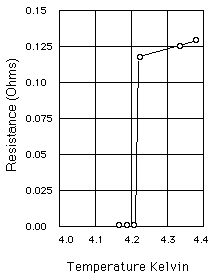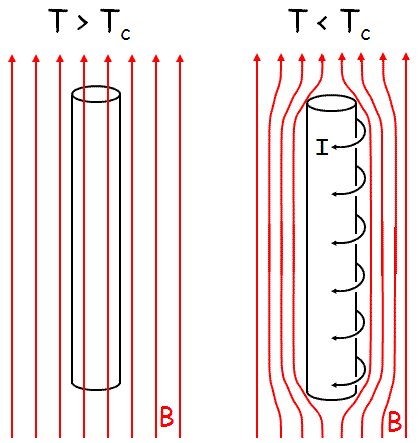Superconductivity
A superconductor is a material which exhibits the following two properties:
 Fig. 1(a) Vanishing of electrical resistivity below a critical temperature Tc, discovered in mercury by Kamerlingh-Onnes in 1911. |
 Fig. 1(b) Expulsion of magnetic flux below a critical field Hc, discovered by Meissner and Ochsenfeld in 1933. |
Conventional Superconductors
The vanishing of electrical resistivity was first discovered in mercury at T = 4.21 K by Kamerlingh-Onnes in 1911. Expulsion of magnetic field was discovered by Meissner and Ochsenfeld in 1933. Over the next several decades, theorists struggled to find a microscopic theory for superconductivity. Major advances were made with the London theory in 1935 and the Ginzberg-Landau theory in 1950. But it was not until 1957, a whole 46 years after the original experimental discovery of superconductivity, that a universally accepted microscopic theory of the phenomenon was put forth by Bardeen, Cooper, and Schrieffer.
The basic idea of BSC theory is that electrons (fermions) pair via phonon coupling, and the pairs (now bosons) condense into a single coherent ground state which allows the electrons to move cooperatively through the crystal without scattering. The underlying points of the theory are:
- The Fermi surface is unstable to infinitesimal attractive forces.
- Phonon coupling provides an attractive force.
Some of the key experiments that led to this realization were:
- The density of states is gapped at the Fermi surface. This was determined experimentally first by a measurement of an exponential specific heat. This led to the realization that some kind of pairing is occurring (i.e. electrons are thermally activated across a gap with Boltzmann probability). It was later confirmed by electromagnetic absorption in aluminum and lead.
- Phonons are involved. This was shown experimentally by the isotope effect: the critical temperature Tc was found to vary as the inverse square root of the nuclear mass. Since the phonon frequency varies as sqrt(k/M), the discovery of the isotope effect led to the realization that phonons are involved.
Armed with these and other experimental facts, BCS were finally able to put the whole picture together. Numerous details were filled in over the next few decades, but the problem of superconductivity was largely considered solved by BCS in 1957.
High-Temperature Superconductors
For obvious technological reasons, the search continued for materials which could superconduct at higher temperatures. Despite much work, for decades the highest Tc's belonged to Nb3Sn (18K) then Nb3Ge (23K), and the field was considered by many to be at a dead end. A history of the increase in record Tc is shown in figure 2.

Figure 2: Discovery of materials with successively higher Tc's over the last century. (Points circled in red garnered a Nobel Prize for their discoverers: Kamerlingh-Onnes in 1913 and Bednorz & Müller in 1987.)
Discovery and Initial Questions
Three decades after BCS, in 1986, a startling discovery reopened the field of superconductivity research. Bednorz and Müller working at IBM in Switzerland discovered a new class of superconducting materials LaBaCuO (30 K). The following year, the liquid nitrogen temperature barrier (77 K) was broken with the discovery of YBa2Cu3O7-x, superconducting at 90K. Soon a whole host of related materials were found. Since the common element in all these new high temperature superconductors is a CuO2 plane, these materials are referred to as the "cuprates."
The discovery of superconductivity in the cuprates was surprising for several reasons. No previous oxide superconductors had ever been found. Furthermore, in their stoichiometric form (with no additional oxygen or other dopant atoms added) these materials are antiferromagnetic Mott insulators. It is conventional wisdom that magnetism cannot coexist with superconductivity. For example, Abrikosov and Gor'kov showed that magnetic impurities disrupt superconductivity and depress Tc.
The obvious differences between these new high-temperature superconductors (HTSCs) and the old conventional superconductors created a great deal of excitement. Rapidly, all the old experiments which had lead to the unifying theory of conventional superconductors were repeated. But the results were often confusing and/or contradictory.
Pairing
It is now generally agreed that there is a gap in the density of states, but instead of the simple symmetric s-wave gap found in conventional superconductors, the gap in cuprates is dx2-y2-wave. This was shown by Wollman et al by flux modulation measurements in a YBCO DC-SQUID and then more unambiguously Tseui et al by flux quantization in a tri-crystal YBCO junction. This means that electrons traveling different directions in the crystal feel a different pairing potential.
As would be expected from the gap in the density of states, it is generally agreed that electrons are paired. It was shown unambiguously by measurement of h/2e flux quanta by Gough et al, which indicates that the charge carriers have charge 2e.
It is not generally agreed what causes the pairing. Of course the first thing to look for is phonons, but tests for the isotope effect have been inconclusive, in part because it's not clear which phonons are key. The cuprate crystal structures are much more complicated than the conventional superconductors, with typically four or five different elements per unit cell. Different atoms are involved in different phonons, so it's not obvious which isotope should be varied. No clear dependence of Tc on isotope has been found.
Because magnetism is known to play a role in the crystal at low carrier concentration, many argue strongly that electron pairing in high temperature superconductivity is caused by magnons or other magnetic consequences. But there are also arguments (e.g. by Lanzara et al) that pairing is indeed caused by phonons.
Doping
Perhaps the most notable complicating factor in the high-Tc superconductors is the existence of a whole new parameter which can be tuned: carrier concentration. This leads to a 3-dimensional phase diagram rather than the simple temperature vs. B-field phase diagram of the conventional superconductors. In HTSC materials, the stoichiometric parent compounds are insulators, and it is not until charge carriers are added that these materials become superconducting. Typically charge carriers in the form of holes are added by doping oxygen interstitially (e.g. Bi2Sr2CaCu2O8+x), by substituting a monovalent atom with a divalent atom (e.g. replacing La with Sr in La2-xSrxCuO2), or by removal of oxygen from their stoichiometric positions (e.g. YBa2Cu3O7-x). In any case, the carrier concentration is an important variable upon which the properties of the material depend strongly. We now have a 3-dimensional phase diagram, as shown in figure 3.

Figure 3:High-Tc 3-dimensional phase diagram. The state of the system is parameterized by carrier concentration (doping), temperature, and magnetic field. Two known phases are antiferromagnetism (at low doping) and superconductivity; little is known about the electronic structure throughout the rest of phase space.
In addition, there have also been discovered many electron-doped superconductors, with a phase diagram that is roughly the mirror image of the hole-doped materials. But for some reason the electron-doped materials do not have as high Tc's.